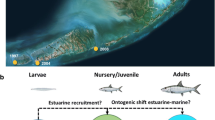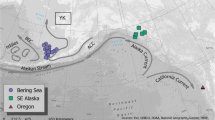Abstract
Isotopic ratios of fish otoliths have been used in numerous studies as natural tags or markers to aid in the study of connectivity among fish populations. We investigated the use of spatial and temporal changes in the stable carbon and oxygen isotope ratios of otoliths to differentiate juvenile habitats of winter flounder (Pseudopleuronectes americanus). Young-of-the-year (YOY) juvenile winter flounder were collected annually over a three-year period from 18 stations along the coast of Rhode Island, USA. Sagittal otoliths were removed from fish and analyzed for stable carbon (13C/12C or δ13C) and oxygen (18O/16O or δ18O) isotope ratios using continuous flow isotope ratio mass spectrometry. Differences in isotope ratios were observed among stations and along salinity gradients in the Narragansett Bay estuary and an estuarine river system (Narrow River). Overall, the isotope ratio patterns observed among stations were consistent over the three sampling years; however, differences were noted in isotope ratios and the magnitude of the isotope ratio gradients among years. Significant positive correlations were noted between salinity and δ13C for two of the three years. For each of the three years sampled there was a highly significant positive correlation (2002, r = 0.93, P < 0.01; 2003, r = 0.85, P < 0.01; 2004, r = 0.97, P < 0.01) between δ18O and the salinity of the collection site. Also, there was a significant negative correlation between the number of months of above average river flow and δ18O for the three sampling years (r = 0.99, P < 0.05). These findings suggest that yearly changes in the volume of freshwater inputs to these estuarine habitats may be related to the differences observed in otolith δ18O isotope ratios. Because of these year-to-year differences, sampling of each cohort may be necessary in order to use this isotopic technique for winter flounder connectivity studies.







Similar content being viewed by others
References
Anderson TF, Arthur MA (1983) Stable isotopes of oxygen and carbon and their application to sedimentologic and paleoenvironmental problems. In: Arthur MA, Anderson TF, Kaplan IR, Veizer J, Land LS (ed) Stable isotopes in sedimentary geology—Society of Economic and Paleontologists and Mineralogists Short Course #10, Dallas, pp 1–151.
Andrews JE, Greenaway AM, Dennis PF (1998) Combined carbon isotope and C/N ratios as indicators of source and fate of organic matter in a poorly flushed, tropical estuary: Hunts Bay, Kingston Harbour, Jamaica. Estuar Coast Shelf Sci 46:743–756
Augley J, Huxham M, Fernandes TF, Lyndon AR, Bury S (2007) Carbon stable isotopes in estuarine sediments and their utility as migration markers for nursery studies in the Firth of Forth and Forth Estuary, Scotland. Estuar Coast Shelf Sci 72:648–656
Bastow TP, Jackson G, Edmonds JS (2002) Elevated salinity and isotopic competition of fish otolith carbonate: stock delineation of pink snapper, Pagrus auratus, in Shark Bay, Western Australia. Mar Biol 142:801–806
Beck MW, Heck KL Jr, Able KW, Childers DL, Eggleston DB, Gillanders BM, Halpern B, Hays CG, Hoshino K, Minello TJ, Orth RJ, Sheridan PF, Weinstrin MP (2001) The identification, conservation, and management of estuarine and marine nurseries for fish and invertebrates. Bioscience 51:633–641
Chittaro PM, Finley RJ, Levin PS (2009) Spatial and temporal patterns in the contribution of fish from their nursery habitats. Oecologia 160:49–61
Collie JS, Wood AD, Jeffries HP (2008) Long-term shifts in species composition of a coastal fish community. Can J Fish Aquat Sci 65:1352–1365
Coplen TB, Kendall C (2000) Stable isotope and oxygen isotope ratios for selected sites of the US Geological Survey’s NASQAN and Benchmark surface-water networks: US Geological Survey Open-File Report 00–160, pp 409.
Dahlgren CP, Kellison GT, Adams AJ, Gillanders BM, Kendall MS, Layman CA, Ley JA, Nagelkerken I, Serafy JE (2006) Marine nurseries and effective juvenile habitats: concepts and applications. Mar Ecol Prog Ser 312:291–295
Dutton A, Wilkinson BH, Welker JM, Bowen GJ, Lohmann KC (2005) Spatial distribution and seasonal variation in 18O/16O of modern precipitation and river water across the conterminous USA. Hydrol Process 19:4121–4146
Epstein S, Buchsbaum R, Lowenstam HA, Urey HC (1953) Revised carbonate-water isotopic temperature scale. Geol Soc Am Bull 64:1315–1325
Gat JR (1996) Oxygen and hydrogen isotopes in the hydrologic cycle. Annu Rev Earth Planet Sci 24:225–262
Gao Y (2002) Regime shift signatures from stable oxygen isotopic records of otoliths of Atlantic cod (Gadus morhua). Isotopes Environ Health Stud 38:251–263
Gao YW, Beamish RJ (1999) Isotopic composition of otoliths as a chemical tracer in population identification of sockeye salmon (Oncorhynchus nerka). Can J Fish Aquat Sci 56:2062–2068
Gao Y, Schwarcz HP, Brand U, Moksness E (2001) Seasonal records of otoliths from ocean-pen reared and wild cod, Gadus morhua. Environ Biol Fish 61:445–453
Gauldie RW (1996) Biological factors controlling the carbon isotope record in fish otoliths: Principles and evidence. Comp Biochem Physiol 115B:201–208
Gearing JN, Gearing PJ, Rudnick DT, Requejo AG, Hutchins MJ (1984) Isotopic variability of organic carbon in a phytoplankton-based, temperate estuary. Geochim Cosmochim Acta 48:1089–1098
Gillanders BM (2002) Temporal and spatial variability in elemental composition of otoliths: implications for determining stock identity and connectivity of populations. Can J Fish Aquat Sci 59:669–679
Goldberg R, Phelan B, Pereira J, Hagan S, Clark P, Bejda A, Calabrese A, Studholme A, Able KW (2002) Variability in habitat use by young-of-the-year Winter flounder, Pseudopleuronectes americanus, in three Northeastern U.S. estuaries. Estuaries 25:215–226
Guiguer KRRA, Drimmie R, Power M (2003) Validating methods for measuring δ18O and δ13C in otoliths from freshwater fish. Rapid Commun Mass Spectrom 17:463–471
Hamer PA, Jenkins GP, Gillanders BM (2003) Otolith chemistry of juvenile snapper Pagrus auratus in Victorian waters: natural chemical tags and their temporal variation. Mar Ecol Prog Ser 263:261–273
Høie H, Anderson C, Folkvord A, Karlsen O (2004) Percision and accuracy of stable isotope signals in otoliths of pen-reared cod (Gadus morhua) when samples with a high-resolution micromill. Mar Biol 144:1039–1049
Kalish JM (1991) 13C and 18O isotopic disequilibria in fish otoliths: metabolic and kinetic effects. Mar Ecol Prog Ser 75:191–203
Kelly RP, Moran SB (2002) Seasonal changes in groundwater input to a well-mixed estuary estimated using radium isotopes and implications for coastal nutrient budgets. Limnol Oceanogr 47:1796–1808
Kerr LA, Secor DH, Kraus RT (2007) Stable isotope (δ13C and δ18O) and Sr/Ca composition of otoliths as proxies for environmental salinity experienced by an estuarine fish. Mar Ecol Prog Ser 349:245–253
Lazzari MA (2008) Habitat variability in young-of-the-year winter flounder, Pseudopleuronectes americanus, in Maine estuaries. Fish Res 90:296–304
Lee V, Olsen S (1985) Eutrophication and management initiatives for the control of nutrient inputs to Rhode Island Coastal Lagoons. Estuaries 8:191–202
Nelson CS, Northcote TG, Hendy CH (1989) Potential use of oxygen and carbon isotopic composition of otoliths to identify migratory and non-migratory stocks of the New Zealand common smelt: a pilot study. New Zeal J Mar Freshwat Res 23:337–344
Northcote TG, Hendy CH, Nelson CS, Boubee JAT (1992) Tests for migratory history of the New Zealand common smelt (Retropinna retropinna (Richardson)) using otolith isotopic composition. Ecol Freshwat Fish 1:61–72
Pilson MEQ (1985) On the residence time of water in Narragansett Bay. Estuaries 8:2–14
Pruell RJ, Taplin BK, Karr JD (2010) Stable carbon and oxygen isotope ratios of otoliths differentiate juvenile winter flounder habitats. Mar Freshwat Res 61:34–41
Radtke RL, Showers W, Moksness E, Lenz P (1996) Environmental information stored in otoliths: insights from stable isotopes. Mar Biol 127:161–170
Riera P, Richard P (1996) Isotopic determination of food sources of Crassostrea gigas along a trophic gradient in the estuarine bay of Marennes-Oléron. Estuar Coast Shelf Sci 42:347–360
Saucerman SE, Deegan LA (1991) Lateral and cross-channel movement of young-of-the-year Winter Flounder (Pseudopleuronectes americanus) in Waquoit Bay, Massachusetts. Estuaries 14:440–446
Schloesser RW, Neilson JD, Secor DH, Rooker JR (2010) Natal origin of Atlantic bluefin tuna (Thunnus thynnus) from Canadian waters based on otolith δ13C and δ18O. Can J Fish Aquat Sci 67:563–569
Solomon CT, Weber PK, Cech JJ Jr, Ingram BL, Conrad ME, Machavaram MV, Pogodina AR, Franklin RL (2006) Experimental determination of the sources of otolith carbon and associated isotopic fractionation. Can J Fish Aquat Sci 63:79–89
Tanner SE, Vasconcelos RP, Reis-Santos P, Cabral HN, Thorrold SR (2010) Spatial and ontogenetic variability in the chemical composition of juvenile common sole (Solea solea) otoliths. Estuar Coast Shelf Sci 91:150–157
Thorrold SR, Campana SE, Jones CM, Swart PK (1997) Factors determining δ13C and δ18O fractionation in aragonitic otoliths of marine fish. Geochim Cosmochim Acta 61:2909–2919
US Geological Survey (2010) USGS Surface-water monthly statistics for the nation. http://waterdata.usgs.gov. Accessed 14 Jan 2010.
Walther BD, Thorrold SR (2008) Continental-scale variation in otolith geochemistry of juvenile American shad (Alosa sapidissima). Can J Fish Aquat Sci 65:2623–2635
Walther BD, Thorrold SR (2009) Inter-annual variability in isotope and elemental ratios in otoliths of an anadromous fish. J Geochem Explor 102:181–186
Weidman CR, Millner R (2000) High-resolution stable isotope records from North Atlantic cod. Fish Res 46:327–342
West JB, Bowen GJ, Cerling TE, Ehleringer JR (2006) Stable isotopes as one of nature’s ecological recorders. Trends Ecol Evol 21:408–414
Acknowledgements
We would like to thank Jennifer Yordy for assistance with the field collection of juvenile winter flounder, James Heltshe for the statistical analyses and Patricia DeCastro and Doug McGovern for help with the graphics. Sample collections were conducted under permit from the Rhode Island Department of Environmental Management. The research for this article was supported by the US EPA, but has not been subject to agency review, and therefore does not necessarily reflect the views of the Agency. No official endorsement should be inferred. This is contribution number AED-10-004 of the Atlantic Ecology Division of the National Health and Ecological Effects Laboratory, Office of Research and Development, U.S. Environmental Protection Agency. Mention of trade names or commercial products does not constitute endorsement or recommendation for use.
Author information
Authors and Affiliations
Corresponding author
Rights and permissions
About this article
Cite this article
Pruell, R.J., Taplin, B.K. & Karr, J.D. Spatial and temporal trends in stable carbon and oxygen isotope ratios of juvenile winter flounder otoliths. Environ Biol Fish 93, 61–71 (2012). https://doi.org/10.1007/s10641-011-9890-3
Received:
Accepted:
Published:
Issue Date:
DOI: https://doi.org/10.1007/s10641-011-9890-3




